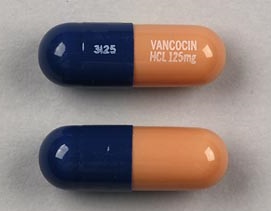Vancomycin Side Effects
Medically reviewed by Drugs.com. Last updated on Oct 30, 2023.
For healthcare professionals
Applies to vancomycin: compounding powder, intravenous powder for injection, intravenous solution, oral capsule, oral powder for reconstitution, oral solution.
General adverse events
The most commonly reported side effects include nausea, abdominal pain, and hypokalemia.[Ref]
Gastrointestinal
- Very common (10% or more): Nausea (up to 17%), abdominal pain (up to 15%)
- Common (1% to 10%): Vomiting, diarrhea, flatulence
- Uncommon (0.1% to 1%): Mild gastrointestinal tract disturbances
- Very rare (less than 0.01%): Pseudomembranous enterocolitis/colitis
- Frequency not reported: Chemical peritonitis, constipation, indigestion, stomachache[Ref]
Chemical peritonitis occurred with intraperitoneal administration.
Mild gastrointestinal tract disturbances occurred with oral administration.[Ref]
Metabolic
- Very common (10% or more): Hypokalemia (up to 13%)[Ref]
Dermatologic
- Common (1% to 10%): Exanthema, pruritus, vancomycin infusion reaction, redness of the face/upper arms, urticaria
- Uncommon (0.1% to 1%): Erythema, itch
- Rare (0.01% to 0.1%): Toxic epidermal necrolysis
- Very rare (less than 0.01%): Exfoliative dermatitis, linear IgA bullous dermatosis, Lyell's syndrome, Stevens-Johnson syndrome
- Frequency not reported: Acute generalized exanthematous pustulosis (AGEP), erythematous macular rash with intense pruritus over face/neck/upper body, rash, red neck[Ref]
Cardiovascular
- Common (1% to 10%): Decrease in blood pressure, flushing of the upper body, peripheral edema, phlebitis
- Uncommon (0.1% to 1%): Thrombophlebitis
- Rare (0.01% to 0.1%): Vasculitis
- Very rare (less than 0.01%): Cardiac arrest
- Frequency not reported: Bradycardia, cardiogenic shock, generalized flushing, hypotension, palpitations, substernal pressure, tachycardia
- Postmarketing reports: Chest pain[Ref]
Hypotension, bradycardia, cardiogenic shock, and cardiac arrest have occurred with rapid bolus administration.[Ref]
Renal
- Common (1% to 10%): Increased serum creatinine, increased serum urea, nephrotoxicity, renal insufficiency
- Rare (0.01% to 0.1%): Acute renal failure, interstitial nephritis
- Frequency not reported: Acute kidney injury, Acute tubular necrosis, azotemia, blood urea nitrogen (BUN) concentrations increased, uremia, transient increased urea[Ref]
Renal failure was most commonly characterized by increased serum creatinine levels or BUN concentrations.
Azotemia usually resolved upon discontinuation of treatment.[Ref]
Other
- Common (1% to 10%): Fatigue, mucosal inflammation, pyrexia
- Uncommon (0.1% to 1%): Chills, fever, pain, permanent hearing loss, transient hearing loss
- Rare (0.01% to 0.1%): Drug fever, ototoxicity, rigors, shivering, tinnitus[Ref]
Respiratory
- Common (1% to 10%): Dyspnea, stridor
- Frequency not reported: Wheezing[Ref]
Musculoskeletal
- Common (1% to 10%): Back pain
- Rare (0.01% to 0.1%): Back and chest muscle pain and spasm[Ref]
Nervous system
- Common (1% to 10%): Headache
- Rare (0.01% to 0.1%): Dizziness, vertigo[Ref]
Genitourinary
- Common (1% to 10%): Urinary tract infection
- Frequency not reported: Granular urinary casts[Ref]
Hematologic
- Uncommon (0.1% to 1%): Eosinophilia,
- Rare (0.01% to 0.1%): Agranulocytosis, leukopenia, pancytopenia, reversible agranulocytosis, reversible neutropenia, thrombocytopenia
- Frequency not reported: Anemia[Ref]
Hypersensitivity
- Rare (0.01% to 0.1%): Anaphylactic reactions, anaphylaxis, hypersensitivity reactions
- Frequency not reported: Anaphylactoid reaction[Ref]
Immunologic
- Rare (0.01% to 0.1%): Superinfection
- Frequency not reported: Drug rash with eosinophilia and systemic symptoms (DRESS), non-susceptible organism overgrowth[Ref]
Local
- Frequency not reported: Injection site inflammation, injection site pruritus, necrosis, tissue irritation[Ref]
Ocular
- Frequency not reported: Hemorrhagic occlusive retinal vasculitis (HORV), permanent vision loss[Ref]
HORV occurred in patients given this drug via intracameral or intravitreal route during/after cataract surgery.[Ref]
Psychiatric
- Frequency not reported: Depression, insomnia[Ref]
Hepatic
- Frequency not reported: Transaminase elevations[Ref]
See also:
References
1. (2001) "Product Information. Vancocin (vancomycin)." Lilly, Eli and Company
2. Cerner Multum, Inc. "UK Summary of Product Characteristics."
3. Cerner Multum, Inc. "Australian Product Information."
4. Infectious Diseases Society of America (2021) Position on Terminology for Vancomycin Flushing Reactions. https://www.hivma.org/globalassets/idsa/public-health/covid-19/vanc-flushing-syndrome-idsa-position-statement.pdf
Frequently asked questions
- What are the strongest antibiotics available?
- Can you drink alcohol while taking vancomycin?
- What is the difference between Firvanq and the CutisPharma FIRST-Vancomycin Compounding Kit?
More about vancomycin
- Check interactions
- Compare alternatives
- Pricing & coupons
- Reviews (58)
- Drug images
- Latest FDA alerts (8)
- Dosage information
- Patient tips
- During pregnancy
- Support group
- Drug class: glycopeptide antibiotics
- Breastfeeding
Patient resources
Other brands
Vancocin, Firvanq, Vancocin HCl, Vancocin HCl Pulvules
Professional resources
- Vancomycin monograph
- Vancomycin Capsules (FDA)
- Vancomycin Hydrochloride (FDA)
- Vancomycin Oral Solution (FDA)
Other brands
Related treatment guides
Further information
Vancomycin side effects can vary depending on the individual. Always consult your healthcare provider to ensure the information displayed on this page applies to your personal circumstances.
Note: Medication side effects may be underreported. If you are experiencing side effects that are not listed, submit a report to the FDA by following this guide.

